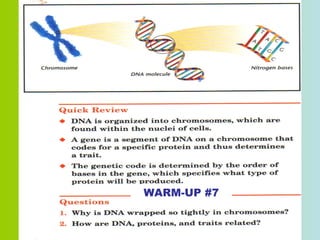
Dna notes
- 1. WARM-UP #7
- 3. Genetic material of cells… • GENES – units of genetic material that CODES FOR A SPECIFIC TRAIT • Called NUCLEIC ACIDS • DNA is made up of repeating molecules called NUCLEOTIDES
- 4. DNA Nucleotide Phosphate Group O O=P-O O 5 CH2 O N C 1 C4 Sugar (deoxyribose) C3 C2 Nitrogenous base (A, G, C, or T)
- 5. A HISTORY OF DNA SEE p. 292-293 • Discovery of the DNA double helix A. Frederick Griffith – Discovers that a factor in diseased bacteria can transform harmless bacteria into deadly bacteria (1928) B. Rosalind Franklin - X-ray photo of DNA. (1952) C. Watson and Crick - described the DNA molecule from Franklin’s X-ray. (1953)
- 6. Watson & Crick proposed… •DNA had specific pairing between the nitrogen bases: ADENINE – THYMINE CYTOSINE - GUANINE •DNA was made of 2 long stands of nucleotides arranged in a specific way called the “Complementary Rule”
- 7. DNA Double Helix “Rungs of ladder” Nitrogenous Base (A,T,G or C) “Legs of ladder” Phosphate & Sugar Backbone
- 9. Nitrogenous Bases • PURINES 1. Adenine (A) 2. Guanine (G) A or G • PYRIMIDINES 3. Thymine (T) 4. Cytosine (C) T or C
- 10. Chargaff’s Rule • Adenine must pair with Thymine • Guanine must pair with Cytosine • Their amounts in a given DNA molecule will be about the same. same T A G C
- 12. Genetic Diversity… • Different arrangements of NUCLEOTIDES in a nucleic acid (DNA) provides the key to DIVERSITY among living organisms.
- 13. The Code of Life… • The “code” of the chromosome is the SPECIFIC ORDER that bases occur. A T C G T A T G C G G…
- 14. See p. 297 DNA is wrapped tightly around histones and coiled tightly to form chromosomes
- 15. DNA Replication • DNA must be copied • The DNA molecule produces 2 IDENTICAL new complementary strands following the rules of base pairing: A-T, G-C •Each strand of the original DNA serves as a template for the new strand See p. 298
- 16. DNA Replication • Semiconservative Model: 1. Watson and Crick showed: the two strands of the parental molecule separate, and each functions as a template for synthesis of a new complementary strand. . Parental DNA DNA Template New DNA
- 17. Replication Quiz A---? G---? C---? 2. When does replication occur? T---? 3. Describe how replication works. A---? G---? A---? 4. Use the complementary rule to G---? create the complementary C---? strand: A---? G---? T---? 1. Why is replication necessary?
- 18. Replication Quiz A---T 1. Why is replication necessary? G---C So both new cells will have the correct C---G DNA T---A 2. When does replication occur? A---T During interphase (S phase). G---C 3. Describe how replication works. A---T Enzymes unzip DNA and complementary G---C nucleotides join each original strand. C---G 4. Use the complementary rule to A---T create the complementary strand: G---C T---A
- 19. (1961) Watson & Crick proposed… • …DNA controlled cell function by serving as a template for PROTEIN structure. • 3 Nucleotides = a triplet or CODON (which code for a specific AMINO ACID) See p.303 • AMINO ACIDS are the building blocks of proteins.
- 20. DNA Transcription • DNA can “unzip” itself and RNA nucleotides match up to the DNA strand. See p.301 • Both DNA & RNA are formed from NUCLEOTIDES and are called NUCLEIC acids.
- 21. DNA Translation • The cell uses information from “messenger” RNA to produce proteins See p.304-305 We will discuss details of this on a later date
- 22. 1. 2. 3. 4. 5. 6. Transcription/Translation Quiz Why is transcription necessary? Describe transcription. Why is translation necessary? Describe translation. What are the main differences between DNA and RNA. Using the chart on page 303, identify the amino acids coded for by these codons: UGGCAGUGC
- 23. 1. Why is transcription necessary? Transcription makes messenger RNA (MRNA) to carry the code for proteins out of the nucleus to the ribosomes in the cytoplasm. 2. Describe transcription. RNA polymerase binds to DNA, separates the strands, then uses one strand as a template to assemble MRNA. 3. Why is translation necessary? Translation assures that the right amino acids are joined together by peptides to form the
- 24. 4. Describe translation. The cell uses information from MRNA to produce proteins. 5. What are the main differences between DNA and RNA. DNA has deoxyribose, RNA has ribose; DNA has 2 strands, RNA has one strand; DNA has thymine, RNA has uracil. 6. Using the chart on page 303, identify the amino acids coded for by these codons: UGGCAGUGC tryptophan-glutamine-cysteine
- 25. AMAZING DNA FACTS… • DNA from a single human cell extends in a single thread for almost 2 meters long!!! • It contains information equal to some 600,000 printed pages of 500 words each!!! (a library of about 1,000 books)
- 26. LET’S REVIEW DNA… LM p.44 1. List the conclusions Griffith & Avery, Hershey & Chase drew from their experiments. 2. Summarize the relationship between genes & DNA. 3. Describe the overall structure of the DNA molecule. 4. What are the 4 kinds of bases?
